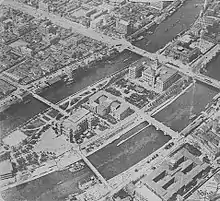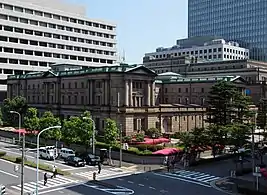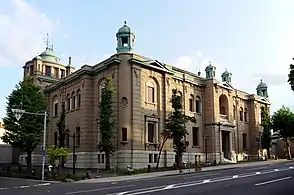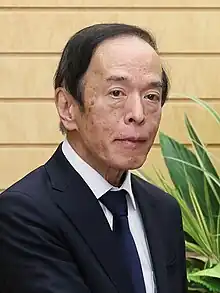Bank of Japan
The Bank of Japan (日本銀行, Nippon Ginkō, BOJ, JASDAQ: 8301) is the central bank of Japan.[3] The bank is often called Nichigin (日銀) for short. It has its headquarters in Chūō, Tokyo.[4]
  Headquarters in Tokyo | |
| Headquarters | Chūō, Tokyo, Japan |
|---|---|
| Coordinates | 35.6861°N 139.7715°E |
| Established | 27 June/10 October 1882 |
| Governor | Kazuo Ueda (9 April 2023 – present) |
| Central bank of | |
| Currency | Japanese yen JPY (ISO 4217) |
| Reserves | 1 179 500 million USD[1] |
| Bank rate | –0.10%[2] |
| Website | boj.or.jp |
History
Like most modern Japanese institutions, the Bank of Japan was founded after the Meiji Restoration. Prior to the Restoration, Japan's feudal fiefs all issued their own money, hansatsu, in an array of incompatible denominations, but the New Currency Act of Meiji 4 (1871) did away with these and established the yen as the new decimal currency, which had parity with the Mexican silver dollar.[5] The former han (fiefs) became prefectures and their mints became private chartered banks which, however, initially retained the right to print money. For a time both the central government and these so-called "national" banks issued money. A period of unanticipated consequences was ended when the Bank of Japan was founded in Meiji 15 (10 October 1882), under the Bank of Japan Act 1882 (27 June 1882), after a Belgian model. It has since been partly privately owned (its stock is traded over the counter, hence the stock number).[6] A number of modifications based on other national banks were encompassed within the regulations under which the bank was founded.[7] The institution was given a monopoly on controlling the money supply in 1884, but it would be another 20 years before the previously issued notes were retired.[8]
Following the passage of the Convertible Bank Note Regulations (May 1884), the Bank of Japan issued its first banknotes in 1885 (Meiji 18). Despite some small glitches—for example, it turned out that the konjac powder mixed in the paper to prevent counterfeiting made the bills a delicacy for rats—the run was largely successful. In 1897, Japan joined the gold standard,[9] and in 1899 the former "national" banknotes were formally phased out.

Since its Meiji era beginnings, the Bank of Japan has operated continuously from main offices in Tokyo and Osaka.
Reorganization
The Bank of Japan was reorganized in 1942[3] (fully only after 1 May 1942), under the Bank of Japan Act of 1942 (日本銀行法 昭和17年法律第67号), promulgated on 24 February 1942. There was a brief post-war period during the Occupation of Japan when the bank's functions were suspended, and military currency was issued. In 1949, the bank was again restructured.[3]
In the 1970s, the bank's operating environment evolved along with the transition from a fixed foreign currency exchange rate and a rather closed economy to a large open economy with a variable exchange rate.[10]
During the entire post-war era, until at least 1991, the Bank of Japan's monetary policy has primarily been conducted via its 'window guidance' (窓口指導) credit controls (which are the model for the Chinese central bank's primary tool of monetary policy implementation), whereby the central bank would impose bank credit growth quotas on the commercial banks. The tool was instrumental in the creation of the 'bubble economy' of the 1980s. It was implemented by the Bank of Japan's then "Business Department" (営業局), which was headed during the "bubble years" from 1986 to 1989 by Toshihiko Fukui (who became deputy governor in the 1990s and governor in 2003).[11]
A major 1997 revision of the Bank of Japan Act was designed to give it greater independence;[12] however, the Bank of Japan has been criticized for already possessing excessive independence and lacking in accountability before this law was promulgated.[13] A certain degree of dependence might be said to be enshrined in the new Law, article 4 of which states:
- In recognition of the fact that currency and monetary control is a component of overall economic policy, the Bank of Japan shall always maintain close contact with the government and exchange views sufficiently, so that its currency and monetary control and the basic stance of the government's economic policy shall be mutually harmonious.
However, since the introduction of the new law, the Bank of Japan has rebuffed government requests to stimulate the economy. [14]
The trail of policies

When the Nixon shock happened in August 1971, the Bank of Japan (BOJ) could have appreciated the currency in order to avoid inflation. However, they still kept the fixed exchange rate as 360Yen/$ for two weeks, so it caused excess liquidity. In addition, they persisted with the Smithsonian rate (308Yen/$), and continued monetary easing until 1973. This created a greater-than-10% inflation rate at that time. In order to control stagflation, they raised the official bank rate from 7% to 9% and skyrocketing prices gradually ended in 1978.
In 1979, when the energy crisis happened, the BOJ raised the official bank rate rapidly. The BOJ succeeded in a quick economic recovery. After overcoming the crisis, they reduced the official bank rate. In 1980, the BOJ reduced the official bank rate from 9.0% to 8.25% in August, to 7.25% in November, and to 5.5% in December in 1981. "Reaganomics" was in vogue in America and USD became strong. However, Japan tried to implement fiscal reconstruction at that time, so they did not stop their financial regulation.
In 1985, the agreement of G5 nations, known as the Plaza Accord, USD slipped down and Yen/USD changed from 240yen/$ to 200yen/$ at the end of 1985. Even in 1986, USD continued to fall and reached 160yen/$. In order to escape deflation, the BOJ cut the official bank rate from 5% to 4.5% in January, to 4.0% in March, to 3.5% in April, 3.0% in November. At the same time, the government tried to raise demand in Japan in 1985, and did economy policy in 1986. However, the market was confused about the rapid fall of USD. After the Louvre Accord in February 1987, the BOJ decreased the official bank rate from 3% to 2.5%, but JPY/USD was 140yen/$ at that time and reached 125yen/$ in the end of 1987. The BOJ kept the official bank rate at 2.5% until May in 1989. Financial and fiscal regulation led to a widespread over-valuing of real estate and investments and Japan faced a bubble at that time.

Zero interest-rate policy started in 1995
After 1990, the stock market and real asset market fell. At that time BOJ regulated markets until 1991 in order to end the bubble.
In January 1995, a terrible earthquake happened and Japanese yen became stronger and stronger. JPY/USD reached 80yen/$, so the BOJ reduced the office bank rate to 0.5% and the yen recovered. The period of deflation started at that time.
In 1999, the BOJ started zero-interest-rate policy (ZIRP), but they ended it despite government opposition when the IT bubble happened in 2000. However, Japan's economic bubble burst in 2001 and the BOJ adopted the balance of current account as the main operating target for the adjustment of the financial market in March 2001 (quantitative relaxation policy), shifting from the zero-interest-rate policy. From 2003 to 2004, Japanese government did exchange intervention operation in huge amount, and the economy recovered a lot. In March 2006, BOJ finished quantitative easing, and finished the zero-interest-rate policy in June and raised to 0.25%.
In 2008, the financial crisis happened, and Japanese economy turned bad again. BOJ reduced the uncollateralized call rate to 0.3% and adopted the supplemental balance of current account policy. In December 2008, BOJ reduced uncollateralized call rate again to 0.1% and they started to buy Japanese Government Bond (JGB) along with commercial paper (CP) and corporate bonds. [15]

Negative interest rates started in 2014.
In 2013, the head of the BOJ (Kuroda) announced a new quantitative easing program (QE). This program would be very large in terms of quantity, but it would also be different in terms of quality—qualitative easing (QQE). In other words, the BOJ would (and did) also purchase riskier assets like stocks and REITs.[16]
In 2016, the BOJ initiated yield curve control (YCC).[17]
In 2016, the BOJ started its negative interest rates policy (NIRP).[17]
Curbing deflation
Following the election of Prime Minister Shinzō Abe in December 2012, the Bank of Japan, with Abe's urging, took proactive steps to curb deflation in Japan. On 30 October 2012, The Bank of Japan announced that it would undertake further monetary-easing action for the second time in a month.[21] Under the leadership of new Governor Haruhiko Kuroda, the Bank of Japan released a statement on 5 April 2013 announcing that it would be purchasing securities and bonds at a rate of 60-70 trillion yen a year in an attempt to double Japan's money base in two years.[22] But by 2016, it was apparent that three years of monetary easing had had little effect on deflation so the Bank of Japan instigated a review of its monetary stimulus program.[23]
Mission

According to its charter, the missions of the Bank of Japan are
- Issuance and management of banknotes
- Implementation of monetary policy
- Providing settlement services and ensuring the stability of the financial system
- Treasury and government securities-related operations
- International activities
- Compilation of data, economic analyses and research activities
Location
The Bank of Japan is headquartered in Nihonbashi, Chūō, Tokyo, on the site of a former gold mint (the Kinza) and, not coincidentally, near the famous Ginza district, whose name means "silver mint". The Neo-baroque Bank of Japan building in Tokyo was designed by Tatsuno Kingo in 1896.
The Osaka branch in Nakanoshima is sometimes considered as the structure which effectively symbolizes the bank as an institution.
- Bank of Japan
 The head office of the Bank of Japan located in Nihonbashi Mainoucho, Chuo-ku, Tokyo
The head office of the Bank of Japan located in Nihonbashi Mainoucho, Chuo-ku, Tokyo The Bank of Japan Osaka Branch
The Bank of Japan Osaka Branch
Governor
| Governor of the Bank of Japan | |
|---|---|
| Style | His Excellency |
| Appointer | The Prime Minister |
| Term length | Five years |
| Inaugural holder | Yoshihara Shigetoshi |
| Formation | 6 October 1882 |
The governor of the Bank of Japan (総裁, sōsai) has considerable influence on the economic policy of the Japanese government.
List of governors
| # | Governor | Took office | Left office |
|---|---|---|---|
| 1 | Yoshihara Shigetoshi | 6 October 1882 | 19 December 1887 |
| 2 | Tomita Tetsunosuke | 21 February 1888 | 3 September 1889 |
| 3 | Kawada Koichiro | 3 September 1889 | 7 November 1896 |
| 4 | Iwasaki Yanosuke | 11 November 1896 | 20 October 1898 |
| 5 | Tatsuo Yamamoto | 20 October 1898 | 19 October 1903 |
| 6 | Shigeyoshi Matsuo | 20 October 1903 | 1 June 1911 |
| 7 | Korekiyo Takahashi | 1 June 1911 | 20 February 1913 |
| 8 | Yatarō Mishima | 28 February 1913 | 7 March 1919[24] |
| 9 | Junnosuke Inoue (First) | 13 March 1919 | 2 September 1923 |
| 10 | Otohiko Ichiki | 5 September 1923 | 10 May 1927 |
| 11 | Junnosuke Inoue (Second) | 10 May 1927 | 12 June 1928 |
| 12 | Hisaakira Hijikata | 12 June 1928 | 4 June 1935 |
| 13 | Eigo Fukai | 4 June 1935 | 9 February 1937 |
| 14 | Seihin Ikeda | 9 February 1937 | 27 July 1937 |
| 15 | Toyotaro Yuki | 27 July 1937 | 18 March 1944 |
| 16 | Keizo Shibusawa | 18 March 1944 | 9 October 1945 |
| 17 | Eikichi Araki (First) | 9 October 1945 | 1 June 1946 |
| 18 | Hisato Ichimada | 1 June 1946 | 10 December 1954 |
| 19 | Eikichi Araki (Second) | 11 December 1954 | 30 November 1956 |
| 20 | Masamichi Yamagiwa | 30 November 1956 | 17 December 1964 |
| 21 | Makoto Usami | 17 December 1964 | 16 December 1969 |
| 22 | Tadashi Sasaki | 17 December 1969 | 16 December 1974 |
| 23 | Teiichiro Morinaga | 17 December 1974 | 16 December 1979 |
| 24 | Haruo Maekawa | 17 December 1979 | 16 December 1984 |
| 25 | Satoshi Sumita | 17 December 1984 | 16 December 1989 |
| 26 | Yasushi Mieno | 17 December 1989 | 16 December 1994 |
| 27 | Yasuo Matsushita | 17 December 1994 | 20 March 1998 |
| 28 | Masaru Hayami | 20 March 1998 | 19 March 2003 |
| 29 | Toshihiko Fukui | 20 March 2003 | 19 March 2008 |
| 30 | Masaaki Shirakawa | 9 April 2008 | 19 March 2013 |
| 31 | Haruhiko Kuroda | 20 March 2013 | 9 April 2023 |
| 32 | Kazuo Ueda | 9 April 2023 | Incumbent |
Monetary Policy Board
As of 9 April 2023, the board responsible for setting monetary policy consisted of the following 9 members:[25]
- Kazuo Ueda, Governor of the BOJ
- Uchida Shinichi, Deputy Governor of the BOJ
- Himino Ryozo, Deputy Governor of the BOJ
- Adachi Seiji
- Nakamura Toyoaki
- Noguchi Asahi
- Nakagawa Junko
- Takata Hajime
- Tamura Naoki
Subsidiaries and properties
Bank of Japan owns 4.7% of the Tokyo Stock Exchange.[26] Since 2020 it has owned more of the market than any other body.[27]
See also
Notes
- Weidner, Jan (2017). "The Organisation and Structure of Central Banks" (PDF). Katalog der Deutschen Nationalbibliothek.
- "Home : 日本銀行 Bank of Japan". Bank of Japan. Archived from the original on 2 June 2020. Retrieved 4 August 2019.
- Nussbaum, Louis Frédéric. (2005). "Nihon Ginkō" in Japan encyclopedia, p. 708., p. 708, at Google Books
- "Guide Map to the Bank of Japan Tokyo Head Office. Archived 2009-06-04 at the Wayback Machine". Bank of Japan. Retrieved 22 December 2009.
- Nussbaum, "Banks", Bank of Japan, p. 69, at Google Books.
- Vande Walle, Willy et al. "Institutions and ideologies: the modernization of monetary, legal and law enforcement 'regimes' in Japan in the early Meiji-period (1868-1889)" Archived 16 May 2013 at the Wayback Machine (abstract). FRIS/Katholieke Universiteit Leuven, 2007; retrieved 17 October 2012.
- Longford, Joseph Henry. (1912). Japan of the Japanese Archived 30 March 2015 at the Wayback Machine, p. 289.
- Cargill, Thomas et al. (1997). The political economy of Japanese monetary policy Archived 28 April 2016 at the Wayback Machine, p. 10.
- Nussbaum, "Banks", Bank of Japan, p. 70, at Google Books
- Cargill, p. 197. Archived 28 April 2016 at the Wayback Machine
- Werner, Richard (2002). "Monetary Policy Implementation in Japan: What They Say vs. What they Do", Asian Economic Journal, vol. 16, no. 2, Oxford: Blackwell, pp. 111–151; Werner, Richard (2001). Princes of the Yen Archived 31 March 2015 at the Wayback Machine, Armonk: M. E. Sharpe.
- Cargill, p. 19. Archived 28 April 2016 at the Wayback Machine
- Horiuchi, Akiyoshi (1993), "Japan" in Chapter 3, "Monetary policies" in Haruhiro Fukui, Peter H. Merkl, Hubrtus Mueller-Groeling and Akio Watanabe (eds), The Politics of Economic Change in Postwar Japan and West Germany, vol. 1, Macroeconomic Conditions and Policy Responses, London: Macmillan. Werner, Richard (2005), New Paradigm in Macroeconomics, London: Macmillan.
- See rebuffed requests by the government representatives at BOJ policy board meetings: e.g. "Minutes of the Monetary Policy Meeting on November 30, 2000". Archived from the original on 17 November 2007. Retrieved 9 September 2010. or refusals to increase bond purchases: Bloomberg News. Archived 29 October 2014 at the Wayback Machine
- Kuroda Haruhiko(2013)財政金融政策の成功と失敗
- "Quantitative and Qualitative Monetary Easing" (PDF). Archived (PDF) from the original on 17 April 2013.
- "Bank of Japan: Japan Yield Curve Control Regime | Columbia SIPA". www.sipa.columbia.edu. Archived from the original on 22 October 2022. Retrieved 11 February 2022.
- Andrew Whiffin (1 April 2019). "BoJ's dominance over ETFs raises concern on distorting influence". Financial Times. Archived from the original on 30 November 2020. Retrieved 25 February 2021.
the BoJ was ranked as a top ten shareholder in some 40 per cent of all Japan's listed companies last year, according to Nikkei.
- "BOJ Becomes Biggest Japan Stock Owner With $434 Billion Hoard". Bloomberg.com. 6 December 2020. Archived from the original on 17 February 2021. Retrieved 25 February 2021.
- "BOJ's ETF buying not distorting markets: Kuroda". Business Times. Reuters. 28 January 2021. Archived from the original on 4 February 2021. Retrieved 25 February 2021.
- "Bank of Japan Expands Asset-Purchase Program". The Wall Street Journal. Archived from the original on 16 November 2017. Retrieved 3 August 2017.
- Riley, Charles (4 April 2013). "Bank of Japan takes fight to deflation". CNN. Archived from the original on 29 October 2020. Retrieved 2 August 2020.
- Stanley White (31 July 2016). "'Helicopter monet' talk takes flight as Bank of Japan runs out of runway". The Japan Times. Reuters. Archived from the original on 4 August 2016. Retrieved 1 August 2016.
- Masaoka, Naoichi. (1914). Japan to America, p. 127. Archived 27 April 2016 at the Wayback Machine
- "Policy Board : 日本銀行 Bank of Japan". www.boj.or.jp. Archived from the original on 7 April 2018. Retrieved 30 April 2018.
- "Bank of Japan to be top shareholder of Japan stocks". Archived from the original on 24 April 2020. Retrieved 20 April 2020.
- "BOJ Becomes Biggest Japan Stock Owner With $434 Billion Hoard". Bloomberg.com. 6 December 2020. Retrieved 12 October 2021.
References and further reading
- Bank of Japan. Functions and operations of the Bank of Japan (Institute for Monetary and Economic Studies, 2nd ed. 2012), online Archived 24 February 2020 at the Wayback Machine
- Cargill, Thomas F., Michael M. Hutchison and Takatoshi Itō. (1997). The political economy of Japanese monetary policy. Cambridge: MIT Press. ISBN 9780262032476; OCLC 502984085 Archived 28 May 2013 at the Wayback Machine
- Hamaoka, Itsuo. A study on the Central Bank of Japan (1902) online
- Longford, Joseph Henry. (1912). Japan of the Japanese. Archived 30 March 2015 at the Wayback Machine New York: C. Scribner's sons. OCLC 2971290
- Masaoka, Naoichi. (1914). Japan to America: A Symposium of Papers by Political Leaders and Representative Citizens of Japan on Conditions in Japan and on the Relations Between Japan and the United States. Archived 30 March 2015 at the Wayback Machine New York: G.P. Putnam's Sons (Japan Society). OCLC 256220
- Nussbaum, Louis Frédéric and Käthe Roth. (2005). Japan Encyclopedia. Cambridge: Harvard University Press. ISBN 978-0-674-01753-5; OCLC 48943301 Archived 4 December 2012 at archive.today
- Ohnuki, Mari, Daisuke Murakami, and Masanori Takashima. "Research on financial and monetary history based on the records of the Bank of Japan Archives: a note." Financial History Review 17.2 (2010):273-280. DOI:10.1017/S096856501000020X
- Sarasas Phra. Money and Banking in Japan (1940) online
- Shizume, Masato. "A History of the Bank of Japan, 1882–2016." (Waseda University, 2016) online Archived 29 May 2020 at the Wayback Machine
- Vande Walle, Willy et al. "Institutions and ideologies: the modernization of monetary, legal and law enforcement 'regimes' in Japan in the early Meiji-period (1868-1889)" Archived 24 August 2011 at the Wayback Machine (abstract). FRIS/Katholieke Universiteit Leuven, 2007.
- Werner, Richard A. (2005). New Paradigm in Macroeconomics: Solving the Riddle of Japanese Macroeconomic Performance. New York: Palgrave Macmillan. ISBN 9781403920737; ISBN 9781403920744; OCLC 56413058 Archived 28 May 2013 at the Wayback Machine
- _____________. (2003). Princes of the Yen: Japan's Central Bankers and the Transformation of the Economy. Armonk, New York: M.E. Sharpe. ISBN 978-0-7656-1048-5; OCLC 471605161 Archived 28 May 2013 at the Wayback Machine
External links
- Official website (in English)
- Building a national currency (1868-99)
- Japan and World Interest Rates, Interest Rates data and chart daily updated by ForexMotion

